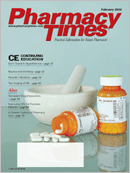Publication
Article
Pharmacy Times
Sanofi-Aventis' Ambien CR (zolpidem tartrate extended-release)
Author(s):
Insomnia is a disorder of initiating ormaintaining sleep or of excess sleepinessthat is characterized as a disturbancein the quantity, quality, or timing ofsleep.1 The 1-year prevalence of insomniais estimated to be between 30% and40% of all adults. It is greater among theelderly.1
Current pharmacologic treatmentsinclude benzodiazepines (BZDs), tricyclicantidepressants, antihis-tamines, andselective BZD receptor agonists, includingzolpidem. Since the addition of zolpidemin 1993, it has become one of themore commonly prescribed sleep medications.In September 2005, Sanofi-Aventis announced FDA approval of itsextended-release formulation of zolpidem,Ambien CR.2
Pharmacology
Zolpidem, an imidazopyridine, is asedative-hypnotic that alters GABAactivity by selectively binding toBZD1 receptors in the brain. Becauseof its selectivity, it has more predominanthypnotic effects and less anxiolytic,anticonvulsant, and myorelaxanteffects than nonselective BZDs.3
Ambien CR is a 2-layer tablet, withthe first layer releasing drug immediatelyand the second allowing a slowerrelease of drug. The mean eliminationhalf-life is 2.8 hours.4
Clinical Trials
Two randomized, controlled trialswere conducted to evaluate the use ofextended-release zolpidem in patientswith primary insomnia. One study evaluated212 adults in a double-blind, randomized,parallel-group, placebo-controlled,3-week trial of Ambien CR 12.5mg. The study found Ambien CR todecrease wake after sleep onset (WASO)for the first 7 hours during the initial 2nights of sleep and for the first 5 hoursafter 2 weeks of treatment. Polysomnographyrecordings showed superiorityover placebo in decreasing latencyto persistent sleep on the first 2 nights oftreatment and after 2 weeks.4
The second study evaluated AmbienCR in 205 elderly participants over theage of 65 with primary insomnia. The trialdesign was similar to that of the first trial,although the dose of Ambien CR wasreduced to 6.25 mg. A decreased WASOalso was observed for the first 7 hoursduring the initial 2 nights and for the first5 hours after 2 weeks. Ambien CR wassuperior to placebo in decreasing latencyto persistent sleep on the first 2 nights oftreatment and after 2 weeks.4
Safety
The safety of Ambien CR is expectedto be comparable to that of the immediate-release formulation. The mostcommon adverse events associatedwith zolpidem include central nervoussystem (CNS) effects such as nausea,dizziness, and drowsiness.3 Becauseelderly patients may have impairedmotor and/or cognitive performance, itis recommended that the dose forthem be reduced to 6.25 mg.4
Ambien CR is a schedule IV medication,and it is in pregnancy category C.There is limited evidence of any significantdrug interactions with zolpidem.Precaution should be taken, however, ifit is used concomitantly with otherCNS depressants.
Outlook
Ambien CR has been shown to besafe and effective for both sleep inductionand sleep maintenance. AmbienCR may be favorable, compared withother sleep medications, because of itstolerability and its side-effect profile.
The recommended dose is 12.5 mgfor adults and 6.25 mg for elderlypatients. Ambien CR should be takenclose to bedtime because of its rapidonset, although the onset may beprolonged if it is taken with food.4
Dr. Soo is a senior research pharmacistwith the Investigational DrugService at Brigham and Women'sHospital, Boston, Mass. Ms. Dascoli isa sixth-year PharmD candidate fromNortheastern University, currently onclinical clerkship in the InvestigationalDrug Service at Brigham andWomen's Hospital.
For a list of references, send astamped, self-addressed envelope to:References Department, Attn. A. Stahl,Pharmacy Times, 241 Forsgate Drive,Jamesburg, NJ 08831; or send an e-mailrequest to: astahl@ascendmedia.com.







